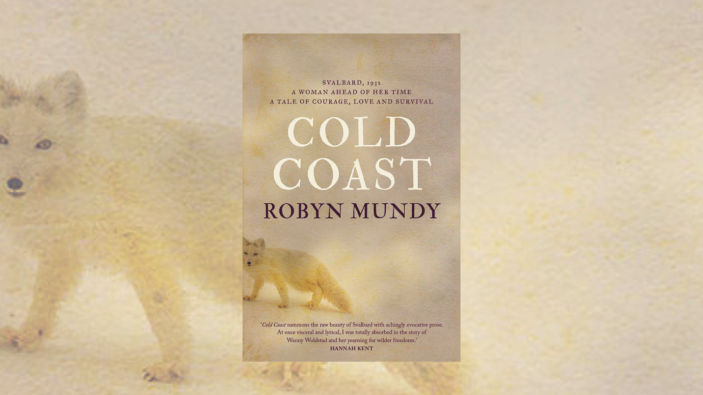
It was a blissful relief to be reading Robyn Mundy‘s latest novel, Cold Coast, over a humid Perth week. The novel is set on Svalbard in 1932, and follows a year in the life of Wanny Wolstadt (pronounced Vanny Voldstadt), who was Norway’s first female trapper.
Wolstadt, a young widow, is already unconventional for a woman of her time, as she runs a taxi service. On manufacturing a meeting with Anders Saeterdal, a well-known Norwegian trapper in search of a partner, she talks her way into the job. Saeterdal finds himself agreeing without really understanding why. The pair set off for a long, difficult sojourn, but at every obstacle, Wanny proves herself equal to the task.
Not only this, but she is a capable housekeeper, and makes the very basic trappers’ huts in which they live much more comfortable. Though at first he is skeptical, soon Saeterdal begins to think of Wanny as an invaluable companion. But he is still a man of his time, and his repeated assertions that Wanny may be too soft to make it in such a masculine profession soon begin to drive a wedge between them.
The novel is made up of alternating chapters, some from the point of view of animals who encounter the humans. In particular, a little blue fox, who was the runt of her litter, studies the humans even as they are searching for her and her kind. They are rare, and their pelts are prized. Like Wanny, the blue fox runt is underestimated by the rest of her kind because she is small, but she proves her worth with her tenacity.
Using this device of having the fox watch the humans, breaks up the narrative nicely. As the pair of hunters were essentially stranded out in the ice and snow for a year, setting and checking traps, there was the risk that their parts of the story could become monotonous, but having this third perspective easily solves that problem. At times later in the novel, Mundy includes other animals’ voices. But, this doesn’t serve the story as well as the perspective of the little blue fox, and was more of a distraction than a layer.
Likewise, there were moments in the human chapters where the perspective would suddenly switch from a third person limited viewpoint in Wanny’s head to being the same but in Anders’, which is somewhat jarring. Despite this, both human characters have strong identities and their motivations are always clear. I loved the way that Mundy played off Saeterdal’s fragile sense of his masculinity with his growing care for Wanny, and the way that she develops the bond between them without venturing into the territory of romance.
Though the book is set in 1932, it has a sort of timeless feel to it, and I think that perhaps comes down to the isolation of much of the setting. It was hard to feel like we were in the 1930s. Wanny and Anders are far away from society, and from the aspects of society that give it any particular historical feel. The only indicator of the time is the persistent attitude to Wanny’s sex.
This is an atmospheric novel reminiscent of Hannah Kent’s Burial Rites, although the plot is less emotional and more intellectual than that novel. It’s plain from reading the book that Mundy is writing about environments and lifestyles that she knows well.
Quite simply, it is a remarkable novel.
![]()
![]()
![]()
![]()
![]()
FOUR AND A HALF STARS (OUT OF FIVE)
Robyn Mundy’s Cold Coast is available now from Ultimo Press. Grab yourself a copy from Booktopia HERE.
